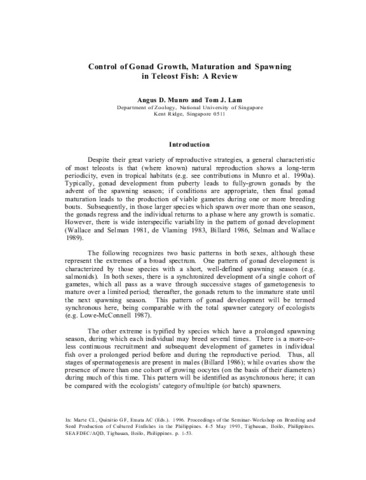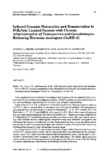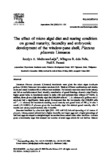| dc.identifier.citation | Lantin-Olaguer, I., & Bagarinao, T. U. (2001). Gonadal maturation, fecundity, spawning and timing of reproduction in the mud snail, Cerithidea cingulata, a pest in milkfish ponds in the Philippines. Invertebrate Reproduction and Development, 39(3), 195-207. | en |
| dc.description.abstract | Gonadal maturation, spawning, fecundity and timing of reproduction of the snail Cerithidea cingulata in a brackish water pond in Molo, Iloilo, Philippines, are described. Snails 4–41 mm in shell length were sampled monthly from May 1997 to May 1998; 25% were <25 mm, 67% were 20–30 mm, and 8% were >30 mm. The sexes are separate and could first be distinguished at 15 mm. Males are aphallic, have narrower shells than females of the same length, and have bright yellow-orange testes overlying the digestive gland deep inside the shell. Females have more robust shells, an ovipositor at the right side of the foot, and yellow-green ovaries overlying the digestive gland. The sex ratio was one male to two females in the pond population studied. Gonadal maturation was monitored by means of gonadosomatic index (GSI, gonad weight as a percent of visceral weight); maturation stages were based on the gonad appearance (immature, developing, mature) and histology (immature, developing, mature, redeveloping). GSI increased with snail size, and reached 16% in a 33-mm female. The smallest mature males and females were 18–19 mm, and most snails >20 mm were mature, spawning, or redeveloping. Histological sections showed all stages of gametogenesis in mature male snails. The oocyte size-frequency distributions in mature females showed mostly mature oocytes and secondary oocytes, but also oogonia and primary oocytes. GSI and the frequency of snails at different maturation stages varied over the year. Both GSI and the frequency of mature snails were highest during the summer months, April to August. Nevertheless, mature snails occurred throughout the whole year, as did mating and egg-laying. Fecundity (= number of oocytes >70 pμ) increased with size in mature females 2041 mm; an average 25-mm female produced about 1,500 oocytes and larger females produced a maximum of about 2,500 oocytes. Eggs strings laid on the pond bottom were 45–75 mm long; an average 64-mm string contained 2,000 eggs 210+20 pm in diameter. The density of eggs strings was highest (80–120/m2) during March-September. Eggs hatched after 6–7 d into planktonic veligers, which in turn settle on the pond bottom 11–12 d later as juveniles. Juveniles 2–6-mm long were most abundant in the pond during August-October. | en |



